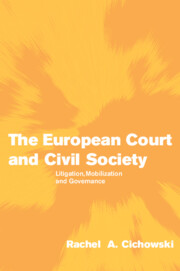Book contents
- Frontmatter
- Contents
- List of figures
- List of tables
- Acknowledgments
- 1 Introduction: institutions, organizations and actors
- 2 Overview of institutionalization in the European Union
- Part I Institutionalization through litigation
- Part II Institutionalization through mobilization
- 5 Women's rights activists: informal to formal organizing
- 6 Collective activism for the environment
- 7 Conclusion: litigation, mobilization and governance
- References
- Index
7 - Conclusion: litigation, mobilization and governance
Published online by Cambridge University Press: 22 September 2009
- Frontmatter
- Contents
- List of figures
- List of tables
- Acknowledgments
- 1 Introduction: institutions, organizations and actors
- 2 Overview of institutionalization in the European Union
- Part I Institutionalization through litigation
- Part II Institutionalization through mobilization
- 5 Women's rights activists: informal to formal organizing
- 6 Collective activism for the environment
- 7 Conclusion: litigation, mobilization and governance
- References
- Index
Summary
The European Court of Justice (ECJ) today is one of the main motors of governance in Europe. It has turned a relatively young body of law into a dynamic and coherent legal system governing and protecting public interests and civil society. This reality was exemplified by a vision put forth by Advocate General Trabucchi thirty years ago and reaffirmed by Advocate General Tesauro in the Court's courageous P.v S. decision (ECJ 1996d: paragraph 24):
If we want Community law to be more than a mere mechanical system of economics and to constitute instead a system commensurate with the society which it has to govern, if we wish it to be a legal system corresponding to the concept of social justice and European integration not only of the economy but of the people, we cannot disappoint the [national] court's expectations, which are more than those of legal form.
(ECJ 1975: 697)All have not welcomed this evolution from the legal to the political, from economic to social justice; some critics have suggested that the Court suffers from “morbid megalomania” or a tendency of “running wild” or engaging in “revolting judicial behavior.” More accurately, one might describe the ECJ as dutiful worker, carrying out the ever challenging and increasingly complex job to which it was mandated almost fifty years ago: “The Court of Justice shall ensure that in the interpretation and application of the Treaty the law is observed” (Article 164 Treaty of Rome).
- Type
- Chapter
- Information
- The European Court and Civil SocietyLitigation, Mobilization and Governance, pp. 242 - 263Publisher: Cambridge University PressPrint publication year: 2007



